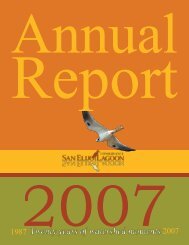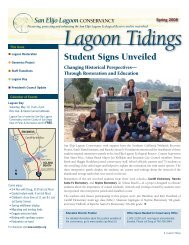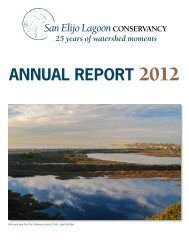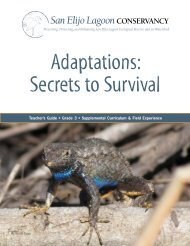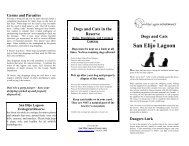Seven Days in December - San Elijo Lagoon Conservancy
Seven Days in December - San Elijo Lagoon Conservancy
Seven Days in December - San Elijo Lagoon Conservancy
Create successful ePaper yourself
Turn your PDF publications into a flip-book with our unique Google optimized e-Paper software.
Storms cont<strong>in</strong>ued from Page 1<br />
What does this k<strong>in</strong>d of ra<strong>in</strong> event mean for <strong>San</strong> <strong>Elijo</strong> <strong>Lagoon</strong> and<br />
other coastal wetlands? Periodic flood<strong>in</strong>g is a normal part of life<br />
<strong>in</strong> riparian zones like Escondido Creek. It’s typically a restorative<br />
event—sediments, nutrients and organic matter carried by storm<br />
flows are moved out of the channel and deposited on the floodpla<strong>in</strong>,<br />
nourish<strong>in</strong>g riparian plants and creat<strong>in</strong>g mixed habitat and protective<br />
cover for aquatic organisms. For an estuary like <strong>San</strong> <strong>Elijo</strong> <strong>Lagoon</strong>,<br />
these same flows would normally move excess sediments and<br />
nutrients out of the lagoon and <strong>in</strong>to the ocean, provid<strong>in</strong>g new sand<br />
for North County beaches.<br />
Unfortunately, <strong>in</strong> an urban watershed, these “normal” hydrological<br />
processes are often compromised by the impacts of <strong>in</strong>creased<br />
population and development. Extensive impervious cover <strong>in</strong> the<br />
watershed (streets, driveways, park<strong>in</strong>g lots, etc.) <strong>in</strong>creases the flood<br />
magnitude and the water velocity over a very short period of time as<br />
this water is delivered almost immediately to storm dra<strong>in</strong>s and their<br />
receiv<strong>in</strong>g waters. Channel bottoms are quickly scoured and banks can<br />
collapse, <strong>in</strong>creas<strong>in</strong>g the sediment loads downstream. These two factors<br />
alone (flood magnitude and velocity) can overwhelm a watershed’s<br />
natural tendency to slow the flood’s flow over the floodpla<strong>in</strong>.<br />
FUN FISH FACTS<br />
<br />
the lagoon. Some of the common species <strong>in</strong>clude Killifish,<br />
<br />
<br />
Clevelandia ios<br />
<br />
<br />
<br />
<br />
Striped mullet<br />
Mugil cephalus<br />
9.0<br />
8.0<br />
Stream Level on Escondido Creek at Cam<strong>in</strong>o del Norte Bridge<br />
Mosquitofish, Carp, Catfish, Green Sunfish, and Blue Gill are<br />
<br />
7.0<br />
Stream Level (feet)<br />
6.0<br />
5.0<br />
4.0<br />
3.0<br />
Mosquitofish<br />
Gambusia aff<strong>in</strong>is<br />
2.0<br />
1.0<br />
0.0<br />
12/1 12/16 12/18 12/20 12/22 12/24 12/26 12/28 12/30<br />
Date <strong>in</strong> 2010<br />
Note how quickly the stream levels rise. This is typical of streams<br />
surrounded by urban development and impervious cover.<br />
Impacts to wetlands <strong>in</strong> arid Southern California are magnified when a<br />
flood event hits harder and faster than it would <strong>in</strong> the absence of urban<br />
<strong>in</strong>fluences. This is why the <strong>Conservancy</strong> is work<strong>in</strong>g with its neighbors<br />
and local cities to make sure that future development <strong>in</strong> the watershed<br />
employs Low Impact Development (LID) concepts and “buffer zones”<br />
around riparian areas. Rema<strong>in</strong><strong>in</strong>g m<strong>in</strong>dful of how water moves <strong>in</strong> a<br />
watershed, and the human activities that change it, is <strong>in</strong>creas<strong>in</strong>gly<br />
important as our coastal population cont<strong>in</strong>ues to grow. <br />
F<strong>in</strong>d us at www.facebook.com/sanelijo.<br />
NEW INVASIVE PLANT FOUND IN THE RESERVE!<br />
Dittrichia<br />
graveolens <br />
on the Gemma Parks loop (Rios Trail). It is an annual herb that<br />
<br />
<br />
<br />
to cl<strong>in</strong>g to cloth<strong>in</strong>g, tires, and equipment. Plant oils may cause<br />
contact dermatitis, headaches, blister<strong>in</strong>g, and itch<strong>in</strong>ess. It<br />
produces copious amounts<br />
of seed (~15,000 seeds per<br />
<br />
once established. Although the<br />
<br />
removed, it is highly likely that<br />
more are present. Please alert us<br />
(plants@<strong>San</strong><strong>Elijo</strong>.org) if you see<br />
it. Do not attempt to remove it.<br />
Rapid response and treatment<br />
<br />
keep it out of our yards and<br />
natural areas.<br />
Photo: R. Preston, Calphotos, Berkeley<br />
6 | <strong>Lagoon</strong> Tid<strong>in</strong>gs W<strong>in</strong>ter 2011




